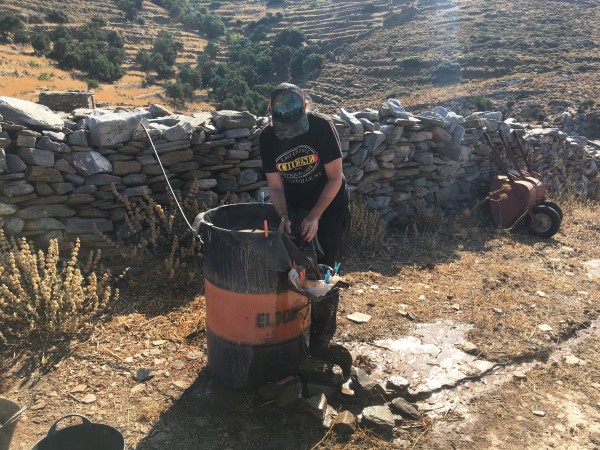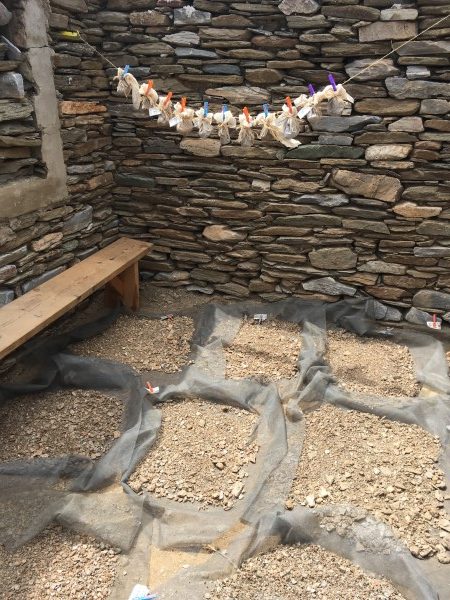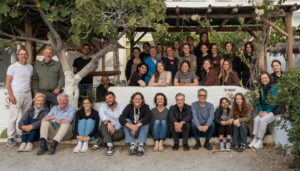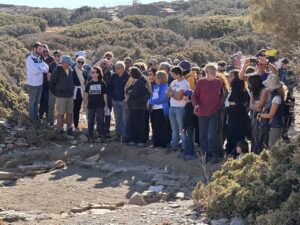Zagora is an exceptionally well-preserved Early Iron Age settlement and as such it provides rich archaeobotanical evidence for the foodstuffs regularly consumed by its inhabitants in the ninth and eighth centuries BC. Flotation is one of the archaeobotanical sampling techniques used on site to investigate ancient plant remains. Flotation captures small finds including grains and seeds that would normally be missed during archaeological excavation.
How are Samples Collected?
Firstly, 10L soil samples are taken from an archaeological deposit. A flotation log is completed and the sample is then placed in the flotation tank. The tank contains fine mesh and is filled with water to dissolve the soil in the sample. This can take anywhere between five minutes and 30 minutes, depending on the sample’s clay content.
Once the soil is dissolved, water is pumped into the base of the tank. Organic remains float to the top and over the lip of the tank where they are collected in a chiffon bag. These materials are called the light fraction and includes plant remains (both ancient and modern), and fragments of bone and shell. The materials that don’t float are called heavy fraction and are captured inside the tank, in the mesh. Heavy fraction can include gravel, small pottery sherds and larger bones. Both the light fraction and the heavy fraction samples are then dried for processing.

How are Samples Processed?
The heavy fraction is sorted and catalogued on site. Human made or manipulated remains, including pottery, worked stone, larger pieces of bone and shell, and occasionally charcoal, are collected and recorded.
Light fraction samples are dried and sent to the lab for processing. An archaeobotanist will then sieve the samples through three geological sieves separating out the different sized grains and seeds. The samples are further sorted between modern and ancient, and general plant species. More detailed analysis is then undertaken as required by the project and the sample.
The time required to process light fraction samples is dependent on the density of the sample. Samples which have no plant remains may take minutes to process, whereas samples full of plant remains may take up to two hours to sort. Unfortunately, due to preservation levels it is common to have samples with no plant remains.

What Affects Botanical Preservation?
There are numerous factors that will influence the preservation of botanical remains at a site. Seeds and grains, like other organic materials do not preserve well in most conditions. Charring, and therefore conditions that lead to charring, are very important in botanical preservation. Charring events are often accidental or forms of discard, where materials are thrown on or near a fire or when a building/storage facility catches on fire. The charring process chemically transforms plant remains (primarily seeds) and allows them to survive within the archaeological matrix for thousands of years. The ideal charring temperature to maximise preservation is 200-300oC. If the temperatures are lower, diagnostic information can be lost through degradation. If the temperature is higher, the seeds and grains maybe reduced to ash and all information lost.
Other challenges to preservation include taphonomic (after burial) processes including ploughing, high water tables and constant wetting and drying of soils. In these situations the decomposition rate of seeds and grains is increased and the amount of information that can be gathered from the sample is reduced.
What can you find through Flotation Sampling?
It is important to remember that due to issues with preservation, the archaeobotanical remains that are collected on a site only make up a tiny sample of the potential agricultural system and culinary practises of the culture being studied. The type of plant remains recovered are also biased towards species that respond best to charring events. Ephemeral foods like fruits, tubers and vegetables do not preserve well. Leafy vegetables are never represented in the archaeological record but were certainly used by ancient cultures. Cereals and pulses are best preserved through charring and are therefore commonly found in flotation samples.
Flotation samples were collected at Zagora during the 2019 season, as also during the 2013 and 2014 excavation seasons. We hope analysis of these samples will be able to identify the seed and grain varieties consumed at the settlement in the Early Iron Age.

